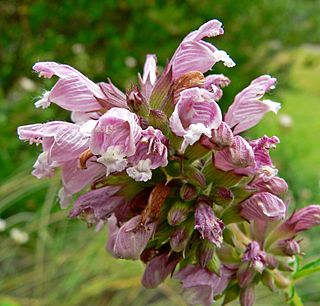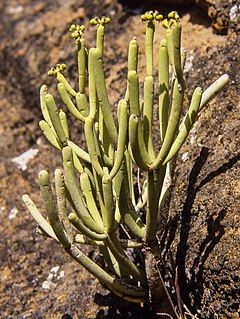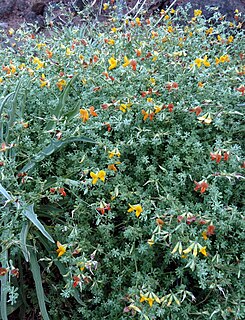
Reseda, also known as the mignonette, is a genus of fragrant herbaceous plants native to Europe, southwest Asia and North Africa, from the Canary Islands and Iberia east to northwest India. The genus includes herbaceous annual, biennial and perennial species 40–130 cm tall. The leaves form a basal rosette at ground level, and then spirally arranged up the stem; they can be entire, toothed or pinnate, and range from 1–15 cm long. The flowers are produced in a slender spike, each flower small, white, yellow, orange, or green, with four to six petals. The fruit is a small dry capsule containing several seeds.

Lotus, a latinization of Greek lōtos, is a genus of flowering plants that includes most bird's-foot trefoils and deervetches and contains many dozens of species distributed worldwide. Depending on the taxonomic authority, roughly between 70 and 150 are accepted. Lotus is a genus of legumes and its members are adapted to a wide range of habitats, from coastal environments to high altitudes.

Argyranthemum is a genus of flowering plants belonging to the family Asteraceae. Members of this genus are sometimes also placed in the genus Chrysanthemum.

Cedronella is a genus of flowering plants in the tribe Mentheae of the family Lamiaceae, comprising a single species, Cedronella canariensis, native to the Canary Islands, the Azores, and Madeira. It is also naturalized in various places. Common names include Canary Islands-balm, Canary balm, and Balm-of-Gilead.

Euphorbia bourgaeana is a species of flowering plant in the spurge family Euphorbiaceae. It is native to Tenerife in the Canary Islands.

Euphorbia balsamifera is a flowering plant in the spurge family Euphorbiaceae. It is distributed in the Canary Islands and the western Sahara. It is the vegetable symbol of the island of Lanzarote. Euphorbia adenensis has been treated as a subspecies of this species.

Aeonium canariense is a species of flowering plant in the family Crassulaceae. It is endemic to the island of Tenerife in the Canary Islands, where it grows on dry slopes and cliffs in the north of the island from sea level to about 1300m. It forms large rosettes of leaves close to the ground but the spikes of yellow flowers stand up to 70 cm tall.

Geranium reuteri, the giant geranium, is a species of flowering plant in the family Geraniaceae, native to the Canary Islands. It was known for many years under the name Geranium canariense. In Spanish, it is called pata de gallo.
Trifurcula ridiculosa is a moth of the family Nepticulidae. It is only known from the Canary Islands: Tenerife, La Palma, La Gomera, El Hierro and Madeira, including Porto Santo island.

Hypericum grandifolium is a species of flowering plant in the St. John's wort family Hypericaceae. It is native to Madeira and the Canary Islands. It is an evergreen shrub up to 1.8 m in height, with dark green, leathery leaves covered with warty glands, and bright yellow flowers up to 4.5 cm broad. It is an important constituent of the shrub layer in the laurisilva of La Gomera.

Euphorbia aphylla is a species of flowering plant in the family Euphorbiaceae. It is native to the Canary Islands. It was first described in 1809.

Erysimum scoparium is a species of flowering plant in the family Brassicaceae, native to the Canary Islands. It is a shrubby species of wallflower with purplish flowers found at high altitudes.

Helianthemum canariense is a species of flowering plant in the family Cistaceae, native to Western Sahara, Morocco and the Canary Islands.

Aeonium aureum is a species of flowering plant in the family Crassulaceae, native to the Canary Islands. It has very short stems, usually with several leaf rosettes. The grey-green leaves are tightly packed and fleshy. The bright yellow flowers are produced on leafy stems, and are up to 25 mm (1 in) across.

Habenaria tridactylites is a species of flowering plant in the family Orchidaceae, native to the Canary Islands. It was first described by John Lindley in 1835.

Heliotropium crispum is a species of flowering plant in the family Boraginaceae, native to western Africa, Egypt, Sudan, south-western Asia, and Pakistan. It was first described by René Louiche Desfontaines.

Nanorrhinum scoparium, synonym Kickxia scoparia, is a species of flowering plant in the family Plantaginaceae.

Retama raetam is a species of flowering plant in the family Fabaceae, native to northern Africa from the Western Sahara to Sudan, Sicily, the Sinai Peninsula, the Palestine region and Saudi Arabia, and widely naturalized elsewhere.

Lotus glaucus is a species of flowering plant in the family Fabaceae, native to Madeira and the Salvage Islands. It is a perennial herbaceous plant with leaves made up of five leaflets. Its flowers are usually orange on opening. Lotus tenellus is included in a more broadly circumscribed L. glaucus by some authors, which extends its distribution to the Canary Islands.

David Bramwell MBE was an English botanist and taxonomist, director of the Jardín Botánico Canario Viera y Clavijo, Gran Canaria (1974–2012), and active in the conservation of insular floras.



















